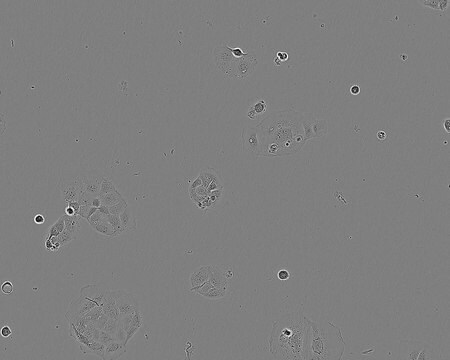U-2 OS Cell Line human
NOTE: Both the cell line and DNA from the cell line may be available for this product. Please choose -1VL or VIAL for cells, or -DNA-5UG for DNA, 92022711, human bone, Not specified
동의어(들):
U-2OS Cells, U2-OS Cells, U20S Cells, U2OS Cells
About This Item
추천 제품
생물학적 소스
human bone
포장
tube of 5 μg 92022711-DNA-5UG
pkg of vial of cells 92022711-1VL
성장 모드
Adherent
핵형
Not specified
형태학
Not specified
제품
Not specified
수용체
Not specified
기술
cell culture | mammalian: suitable
관련 질환(들)
cancer
배송 상태
dry ice
저장 온도
−196°C
세포주 기원
세포주 설명
애플리케이션
- the importance of cyclin D1 for the activity of lithocholic acid hydroxyamide (LCAHA)
- the interaction of human single-stranded DNA binding protein 1 (hSSB1) with bloom syndrome protein helicase (BLM helicase)
- calcium-mediated actin reset (CaAR) in response to physiological changes
DNA 프로파일
CSF1PO: 13
D13S317: 13
D16S539: 11,12
D5S818: 11
D7S820: 11,12
THO1: 6,9.3
TPOX: 11,12
vWA: 14,18
배양 배지
계대배양 정규 작업
기타 정보
가장 최신 버전 중 하나를 선택하세요:
문서
Regulation of the cell cycle involves processes crucial to the survival of a cell, including the detection and repair of genetic damage as well as the prevention of uncontrolled cell division associated with cancer. The cell cycle is a four-stage process in which the cell 1) increases in size (G1-stage), 2) copies its DNA (synthesis, S-stage), 3) prepares to divide (G2-stage), and 4) divides (mitosis, M-stage). Due to their anionic nature, nucleoside triphosphates (NTPs), the building blocks of both RNA and DNA, do not permeate cell membranes.
자사의 과학자팀은 생명 과학, 재료 과학, 화학 합성, 크로마토그래피, 분석 및 기타 많은 영역을 포함한 모든 과학 분야에 경험이 있습니다..
고객지원팀으로 연락바랍니다.



